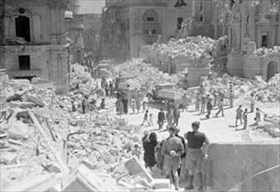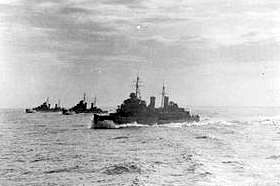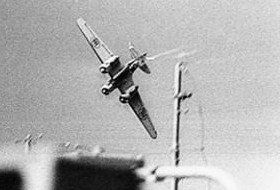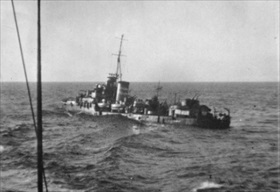ITALY BOMBS MALTA ISLAND FORTRESS
Malta, Central Mediterranean · June 11, 1940
On this date in 1940, one day after Italy entered World War II on the side of Axis partner Nazi Germany, the Italian Royal Air Force opened a nearly nonstop series of air raids on the Mediterranean island of Malta. Lying 50 miles off the Sicilian coast and 200 miles north of the Italian colony of Libya, Malta was a strategically crucial British holding, an “unsinkable aircraft carrier” in the words of Prime Minister Winston Churchill, whose nation had lost the aircraft carrier HMS Glorious in a battle in the Norwegian Sea two days earlier. (The Royal Navy nearly lost the carrier HMS Illustrious east of Sicily to Axis aircraft the following year, on January 10, 1941, and did lose the HMS Ark Royal on November 13, 1941, after the carrier had delivered aircraft to Malta.)
Allied planes and submarines based or simply refueling at Malta prevented over sixty percent of the supplies slated for the Axis North African campaign from getting through. German Afrika Korps commander Erwin Rommel predicted that unless Malta fell into Axis hands, he and his Italian allies would end up losing control of North Africa. Hermann Goering’s Luftwaffe and Benito Mussolini’s Regia Aeronautica thus directed special attention to the island beginning in 1941, flying a total of 3,000 bombing runs over a two-year period in an effort to destroy Malta’s defenses and seaports. In so doing they drove island defenders and civilians underground for years.
Operating from Sicilian and Libyan air bases, the Luftwaffe, taking over the Regia Aeronautica’s unfinished business, achieved air superiority over Malta in the first four months of 1941 just as Rommel’s expeditionary force was being shipped to Libya. Flying through the most concentrated antiaircraft fire on earth, the Luftwaffe managed to drop more bombs on Malta in March and April 1942 than it did on London during the entire Blitz (September 1940 to May 1941). Fortunately for the Maltese, Allied convoys were able to supply and reinforce the island, while the Royal Air Force defended its airspace, though at great cost in material and lives.
On April 15, 1942, King George VI awarded Malta the George Cross, the highest civilian award for gallantry in the Commonwealth, normally awarded to individuals, to honor the island’s quarter-million inhabitants for their bravery. The Maltese placed their treasured award in the capital’s cathedral. Just six months later, by November 1942, Axis fortunes were dealt two Allied knockout blows: a victory at the Second Battle of El Alamein in Egypt and Allied Torch landings in Northwest Africa. (A contemplated high-risk, high-cost Italo-German air-sea invasion of the island (Operazione C3), to be staged chiefly from Sicily, never got close to kicking off: it was postponed in June 1942 and cancelled in July.) Axis attention was quickly yanked away from Malta to the Mediterranean littoral and the Eastern Front, thus effectively ending the island’s siege.
![]()
Axis Siege of Malta, June 1940 to November 1942
 |  |
Left: Service personnel and civilians clear up debris on a bomb-damaged street in Malta’s capital Valletta, April 1942. Beginning in January 1942 Malta became the most heavily bombed place on earth; in two and a half years 14,000 tons of bombs rained down from Axis warplanes, destroying three-quarters of Malta’s buildings. The tiny island (122 sq. miles, or 3 1/2 times the size of New York’s Manhattan) lay smack-dab in the center of the Mediterranean Sea and thus sat at two marine crossroads: Italy’s sea route south to North Africa and Great Britain’s sea route west to Egypt, the Suez Canal, and its Indian and Far Eastern possessions. Whichever country held the Maltese outpost could interrupt the other’s access to strategic military and commercial assets both near and far.
![]()
Right: Three British cruisers provide escort service for Malta-bound supply convoys. Heavily escorted convoys sustained the besieged island during Malta’s darkest hours in mid-1942, a time when Malta had temporarily ceased to be an effective offensive base for the Allies owing to its desperate need of fuel for air and naval forces and food for its military garrison and civilian population. (Malta’s agricultural resources could feed no more than a third of its population.) Small quantities of important supplies were sent by fast warship and submarine during this period.
 |  |
Left: A convoy bound for Malta is attacked by an Italian Savoia Marchetti SM 79 three-engine torpedo bomber. The SM 79 Sparviero (Sparrowhawk) became famous and achieved many successes as a torpedo bomber in the Mediterranean Theater, beginning in July 1940. However, Malta-based single-engine, single-seat Gloster Gladiator biplanes and Hawker Hurricanes began taking the shine off the SM 79’s reputation, erasing the Regia Aeronautica’s numerical advantage and air superiority as more Hurricanes, followed by Spitfires, settled in on Malta’s airbases.
![]()
Right: The HMAS Nestor sinks after being scuttled on June 16, 1942. The Australian destroyer was part of a Malta convoy of 11 merchant ships carrying food, fuel, and supplies to the besieged island. Having left Haifa in Palestine on June 12, the Nestor was heavily damaged by an Italian bomber off Crete. Attempts to tow the ship to base were abandoned.
The Battle for Malta, 1940
![]()

 History buffs, there is good news! The Daily Chronicles of World War II is now available as an ebook for $4.99 on Amazon.com. Containing a year’s worth of dated entries from this website, the ebook brings the story of this tumultuous era to life in a compelling, authoritative, and succinct manner. Featuring inventive navigation aids, the ebook enables readers to instantly move forward or backward by month and date to different dated entries. Simple and elegant! Click
History buffs, there is good news! The Daily Chronicles of World War II is now available as an ebook for $4.99 on Amazon.com. Containing a year’s worth of dated entries from this website, the ebook brings the story of this tumultuous era to life in a compelling, authoritative, and succinct manner. Featuring inventive navigation aids, the ebook enables readers to instantly move forward or backward by month and date to different dated entries. Simple and elegant! Click 











